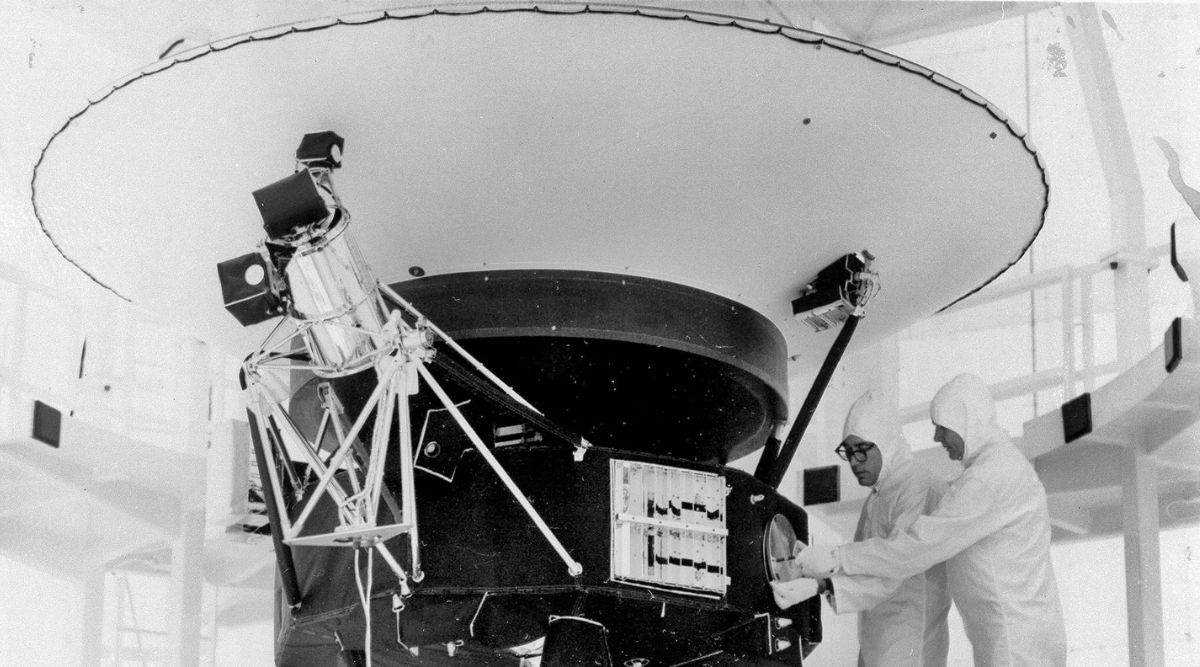Watch this space: Chandrayaan-3 enters lunar orbit, ‘Sun umbrella,’ and Voyager 2
Watch this space: The Chandrayaan-3 mission left Earth's orbit in the same week that NASA regained contact with Voyager-2.
 The fully-integrated Chandrayaan-3 spacecraft and LVM-3 at the launchpad in Sriharikokta. (ISRO/Twitter)
The fully-integrated Chandrayaan-3 spacecraft and LVM-3 at the launchpad in Sriharikokta. (ISRO/Twitter) After going through multiple Earth orbits since it launched on July 14, the Chandrayaan-3 spacecraft moved into a translunar orbit, starting its journey towards the Moon. The spacecraft entered lunar orbit yesterday. In the meanwhile, a scientist has proposed a new “solar umbrella” to mitigate the effects of climate change while NASA lost and then regained contact with the Voyager 2 spacecraft, which is outside of the solar system now.
Chandrayaan-3
The Chandrayaan-3 spacecraft will spend the coming weeks going around the Moon and reducing its velocity in orbit to prepare for a soft landing on Earth’s only natural satellite. It will keep doing this until it reaches a 100 kilometre circular orbit. At that point, the lander and rover will separate from the propulsion module to descend to the surface.
The landing site is a short distance away from where the Chandrayaan-2 spacecraft was meant to land near the Moon’s south pole. If the mission is successful, India will become just the fourth country in the world to achieve a lunar soft landing, behind the United States, the erstwhile Soviet Union and neighbour China.
A soft landing is particularly difficult because, unlike on Earth, the Moon has an extremely thin atmosphere. This means that there is not a lot of friction to slow down the spacecraft before it touches down. In this scenario, the spacecraft is primarily dependent on its propulsion systems to slow down its velocity.
Also, there is no GPS on the Moon. This means that Chandrayaan-3 has no network of satellites to rely on to precisely land at a particular location on the Moon. Therefore, onboard computers will have to make quick calculations to alter the spacecraft’s trajectory to make sure it does not land on boulders or other dangerous locations.
 The Voyager 2 spacecraft being built. (AP, File photo)
The Voyager 2 spacecraft being built. (AP, File photo)
Voyager-2
Flight controllers at NASA accidentally sent a wrong command to the Voyager-2 spacecraft nearly three weeks ago, making the spacecraft tilt its antenna away from Earth. This severed its connection with the spacecraft that is now in interstellar space more than 19 billion kilometres away.
In the past week, the space agency’s Deep Space Network, a series of giant antennas palace across the planet, picked up a “heartbeat signal” from Voyager-2, meaning that it is alive and operating. The space agency is now sending commands to tilt the spacecraft’s antennas in the right direction to communicate with Earth.
Voyager-2 is trailing behind its twin Voyager 1, which is now more than 24 billion kilometres away from Earth. This makes it the most distant man-made object in space. Even Voyager-2 is so far away that it takes more than 18 hours for a radio signal to travel one way.
 Tying the sun shade to an asteroid means it can be lighter without being blown away by solar radiation pressure. (Brooks Bays/UH Institute for Astronomy)
Tying the sun shade to an asteroid means it can be lighter without being blown away by solar radiation pressure. (Brooks Bays/UH Institute for Astronomy)
The proposed ‘Sun umbrella’
The idea to use a large sun shade to reduce the amount of sunlight hitting the planet to mitigate climate change might seem like it is taken straight from a children’s cartoon but that is something that a scientist is actually proposing.
This is not the first time that the idea has been discussed. Various scientists in the past have looked at whether such a solution could be practical in the distant future. An actual sun shade that is large enough to shield us from the Sun’s rays while balancing our planet’s gravity and the force of solar radiation would simply be too massive.
But in a paper published in the Proceedings of the National Academy of Science, István Szapudi, an astronomer at the University of Hawai’i, has come up with an idea to drastically reduce that size—to tie that sunshade to an asteroid.
Instead of just a massive shade floating freely in space, Szapudi proposes that an asteroid could be used as a tethered counterweight. With this approach, he calculates that the mass of the sun shade could be reduced by more than 100 times. But even with this innovative new approach, the shield would weigh about 35,000 tons. Our most powerful rocket, NASA’s Space Launch System, can carry a maximum of less than 70 tons to orbit. This idea will need to be taken back to the drawing board a few times before it becomes practical, if it ever does.
But even with Szapudi’s innovative idea, the shield would weigh about 35,000 tons and would need to be launched from Earth. NASA’s SLS, the most powerful rocket currently in existence, can carry a maximum of less than 70 tons to orbit. The sun shade as a solution for climate change is as impractical as it is curious.







